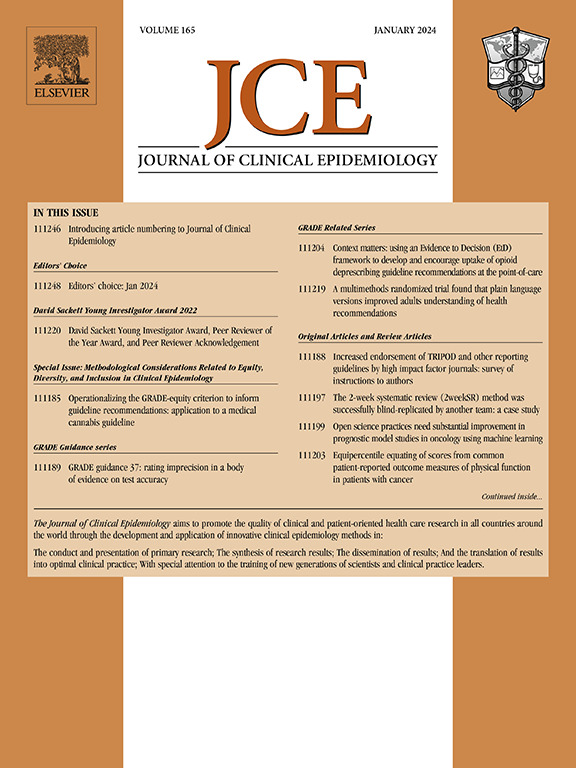Application of methodological strategies to address unmeasured confounding in real-world vaccine safety and effectiveness study: a systematic review
IF 7.3
2区 医学
Q1 HEALTH CARE SCIENCES & SERVICES
引用次数: 0
Abstract
Objectives
Uses of real-world data to evaluate vaccine safety and effectiveness are often challenged by unmeasured confounding. The study aimed to review the application of methods to address unmeasured confounding in observational vaccine safety and effectiveness research.
Study Design and Setting
We conducted a systematic review (PROSPERO: CRD42024519882), and searched PubMed, Web of Science, Embase, and Scopus for epidemiological studies investigating influenza and COVID-19 vaccines as exposures, and respiratory and cardiovascular diseases as outcomes, published between January 1, 2017, and December 31, 2023. Data on study design and statistical analyses were extracted from eligible articles.
Results
A total of 913 studies were included, of which 42 (4.6%, 42/913) accounted for unmeasured confounding through statistical correction (31.0%, 13/42) or confounding detection or quantification (78.6%, 33/42). Negative control was employed in 24 (57.1%, 24/42) studies—2 (8.3%, 2/24) for confounding correction and 22 (91.7%, 22/24) for confounding detection or quantification—followed by E-value (31.0%, 13/42), prior event rate ratio (11.9%, 5/42), regression discontinuity design (7.1%, 3/42), instrumental variable (4.8%, 2/42), and difference-in-differences (2.4%, 1/42). A total of 871 (95.4%, 871/913) studies did not address unmeasured confounding, but 38.9% (355/913) reported it as study limitation.
Conclusion
Unmeasured confounding in real-world vaccine safety and effectiveness studies remains underexplored. Current research primarily employed confounding detection or quantification, notably negative control and E-value, which did not yield adjusted effect estimates. While some studies used correction methods like instrumental variable, regression discontinuity design, and negative control, challenges arise from the stringent assumptions. Future efforts should prioritize developing valid methodologies to mitigate unmeasured confounding.

应用方法学策略解决现实世界疫苗安全性和有效性研究中无法测量的混杂因素:一项系统综述。
目的:使用真实世界的数据来评估疫苗的安全性和有效性经常受到无法测量的混杂因素的挑战。本研究旨在回顾在观察性疫苗安全性和有效性研究中解决未测量混淆的方法的应用。研究设计和设置:我们进行了一项系统评价(PROSPERO: CRD42024519882),并检索了PubMed、Web of Science、Embase和Scopus,检索了2017年1月1日至2023年12月31日期间发表的以流感和COVID-19疫苗为暴露源,以呼吸系统和心血管疾病为结局的流行病学研究。从符合条件的文章中提取有关研究设计和统计分析的数据。结果:共纳入913项研究,其中42项(4.6%,42/913)通过统计校正(31.0%,13/42)或混杂检测/定量(78.6%,33/42)为未测混杂。24项(57.1%,24/42)研究采用阴性对照,其中2项(8.3%,2/24)用于混杂校正,22项(91.7%,22/24)用于混杂检测/定量,随后采用e值(31.0%,13/42)、先验事件率比(11.9%,5/42)、回归不连续设计(7.1%,3/42)、工具变量(4.8%,2/42)和差中差(2.4%,1/42)。共有871项(95.4%,871/913)研究没有解决未测量的混杂因素,但38.9%(355/913)的研究认为这是研究的局限性。结论:现实世界疫苗安全性和有效性研究中未测量的混杂因素仍未得到充分探讨。目前的研究主要采用混杂检测/定量,特别是阴性对照和e值,但没有得到调整后的效应估计。虽然一些研究采用了工具变量、回归不连续设计和负控制等校正方法,但严格的假设带来了挑战。未来的工作应优先发展有效的方法,以减轻未测量的混淆。
本文章由计算机程序翻译,如有差异,请以英文原文为准。
求助全文
约1分钟内获得全文
求助全文
来源期刊

Journal of Clinical Epidemiology
医学-公共卫生、环境卫生与职业卫生
CiteScore
12.00
自引率
6.90%
发文量
320
审稿时长
44 days
期刊介绍:
The Journal of Clinical Epidemiology strives to enhance the quality of clinical and patient-oriented healthcare research by advancing and applying innovative methods in conducting, presenting, synthesizing, disseminating, and translating research results into optimal clinical practice. Special emphasis is placed on training new generations of scientists and clinical practice leaders.
 求助内容:
求助内容: 应助结果提醒方式:
应助结果提醒方式:


